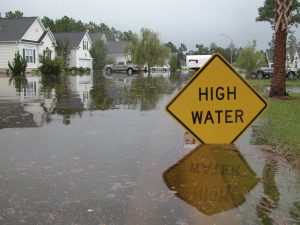

When a severe storm is on the horizon, communities focus on safety and emergency response. However, communities must also prepare for and respond to the impact and aftermath of severe weather on behavioral health. SAMHSA has dedicated resources through the SAMHSA Disaster Technical Assistance Center (DTAC) to support communities that would help prepare for, respond to, and deliver effective mental health and substance use responses to disasters.
Mental Health Impacts – Before, During, and After the Event
Severe weather can affect mental health before, during, and after the event. The toll and trauma that stems from disasters can contribute to stress and anxiety, acute stress reaction, and ability to self-regulate – and for some, posttraumatic stress disorder.
The anticipation of storms can create anxiety or a kind of pre-traumatic stress. With many channels of communication, people are exposed frequently to severe weather warnings – even if they are not at risk – which can increase anxiety. This heightened state of alert is most prevalent in regions that experience disasters often, such as coastal communities vulnerable to hurricanes, towns on fault lines where earthquakes are likely, Tornado Alley, and dry regions prone to fires.
During the event, severe weather can cause injury and disability that may affect mental health. Food shortages, water-borne illnesses, and other infectious diseases may also arise, which can affect the behavioral health of people who manage their health issues, or the health of someone they care for.
The overwhelming consequence of rebuilding in the wake of a disastrous storm can result in stress and sleeplessness, where some may misuse substances, such as alcohol or drugs, to lessen the stress and anxiety, relax, or help with sleep. Grief and depression stemming from the loss of life, home, or employment can take time to recover from. And those displaced from their homes and neighborhoods may experience economic stressors and social effects like the disconnection from neighborhood and community – a disruption from the familiar and routine that helps to stabilize daily life.
Disaster Mental Health Tips
- Self-care
- Physical exercise
- Do things that give you a mental and emotional break
- Reinforce personal and professional boundaries, making space for both
- Connect with others and talk
- Get help when you need it
While familiar routines are central to stability, storms can disrupt normal everyday experiences. They also affect the availability of services that could result in disruptions in counseling or other provider appointments, and access to psychotropic and other medications. Service providers, clinics, and pharmacies can experience power failures, obstructed streets, and building damage – sometimes for prolonged periods of time as communities rebuild. Further exacerbating the situation, there may be an increase on the demand for support services due to injury and trauma resulting from the storm – complicating both delivery and access to critical services.
Planning for Resilience
SAMHSA DTAC offers resources to help communities plan and prepare for thoughtful approaches that consider behavioral health preparations and responses to severe storms and other disasters. This includes online education and training resources, webinars and podcasts on an array of topics, and tip sheets for first responders, community leaders, and disaster survivors. In addition, SAMHSA’s Crisis Counseling Assistance and Training program offers direct, face-to-face psychoeducational outreach and resources. Crisis Counseling is considered strength-based and includes understanding that most disaster survivors are naturally resilient. Crisis Counseling provides support, education, and linkage to needed community resources, to better support survivors in their recovery from disaster.
Using these resources, individuals can learn about disaster-related mental health concerns and substance use, and better cope with disasters. On the SAMHSA DTAC site, first responders will find helpful information on self-care, compassion fatigue, and how to prevent burnout. Resources also provide insight into the planning that behavioral health providers and communities should consider to sustain behavioral health and resilience.
With planning, thoughtful response, and support in the aftermath of severe weather, communities are better able to endure the storms, remain connected to their communities, and know how to address behavioral health concerns that might arise.
SAMHSA’s Disaster Resources
- Disaster Technical Assistance Center (DTAC)
- Distress Helpline (800-985-5990)
- Disaster Mobile App
Resources
- SAMHSA’s Disaster Preparedness
- SAMHSA’s Disaster Technical Assistance Center (DTAC)
- Crisis Counseling Assistance and Training Program (CCP) Toolkit
- Deployment Supports for Disaster Behavioral Health Responders (podcast)
- Disaster Distress Helpline
- Disaster Behavioral Health Information Service (DBHIS) Resource Collections
- Disaster Mental Health Counseling (podcast)
- Mitigating Disaster Trauma: Lessons from Sandy (webinar)
- Promoting Mental Health in the Wake of Disaster (podcast)
- Ready.gov
Related SAMHSA Blogs
- Faith-Based First Responders
- Increasing Community Capacity to Respond to Mental Health Crises
- Providing Support to Individuals and Communities Recovering from Disasters
- 10 Years After Hurricane Katrina, Healing Continues
On SAMHSA’s YouTube Channel
- Disaster Substance Abuse Services: Planning and Preparedness (podcast)
- Introduction to Disaster Behavioral Health
- Post-Disaster Violence Against Women
- SAMHSA’s Behavioral Health Disaster Response App
- Self-care for Disaster Behavioral Health Responders
The post Effects of Severe Weather on Behavioral Health appeared first on .
